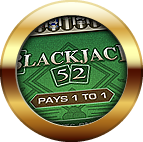Blackjack Card Counting
Basic strategy provides the player with the optimal play for any blackjack situation, based on millions of hands played in the long run. However in the short run, as the cards are dealt from the deck, the remaining deck is no longer complete. By keeping track of the cards that have already been played, it is possible to know when the cards remaining in the deck are advantageous for the player.
Card counting creates two opportunities:
The player can make larger bets when he or she has the advantage. For example, the player can increase the starting bet if there are many aces and tens left in the deck, in the hope of hitting a blackjack.
The player can use information about the remaining cards to improve upon the basic strategy rules for specific hands played. For example, with many tens left in the deck, the player may double down in more situations since there is a better chance of making a strong hand.
There are several card counting systems which do not require that the player remembers which cards have been played. Rather, a point system is established for the cards, and the player keeps track of a simple point count as the cards are played out from the dealer.
Depending on the particular blackjack rules in a given casino, basic strategy reduces the house advantage to less than one percent. Card counting typically gives the player an advantage of 0.5 to 1.5% over the house. To counter card counting, some casinos play with multiple decks.
In most US jurisdictions, card counting is legal and is not considered cheating. However, most casinos have the right to ban players, with or without cause, and card counting is frequently used as a justification to ban a player. Usually, the casino host will simply inform the player that he is no longer welcome to play at that casino. Players must be careful not to signal the fact that they are counting. The use of electronic or other counting devices is usually illegal and almost always prohibited by the casino.

 PLAY FREE BLACKJACK
PLAY FREE BLACKJACK PLAY FREE SPANISH BLACKJACK
PLAY FREE SPANISH BLACKJACK PLAY FREE BLACKJACK 52
PLAY FREE BLACKJACK 52 PLAY FREE BLACKJACK SWITCH
PLAY FREE BLACKJACK SWITCH